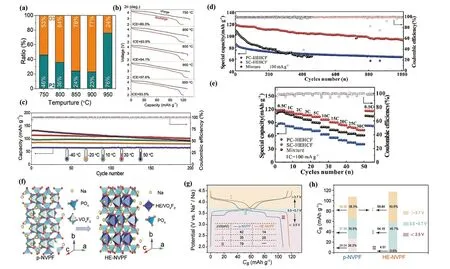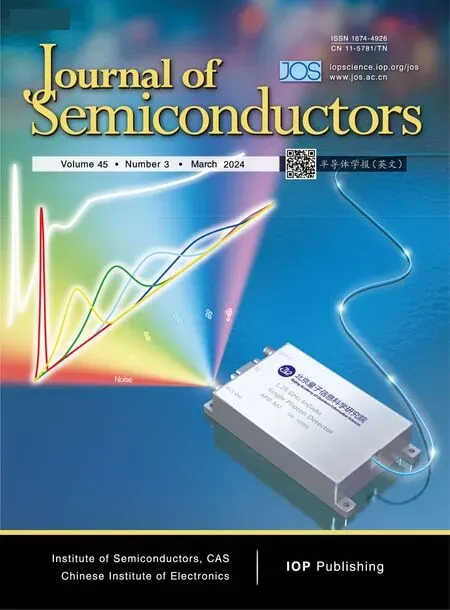Recent progress and future prospects of high-entropy materials for battery applications
Wenbo Qiu ,Zidong Wang ,Shijiang He ,Huaping Zhao ,and Yong Lei†
1Institute of Nanochemistry and Nanobiology,School of Environmental and Chemical Engineering,Shanghai University,Shanghai 200444,China
2Fachgebiet Angewandte Nanophysik,Institut für Physik &IMN MacroNano,Technische Universität Ilmenau,Ilmenau,98693,Germany
Due to the energy crisis caused by limited fossil fuel reserves,extensive use of the renewable energy sources such as wind or solar energy is deemed to replace the use of traditional fossil fuels in the future[1-3].However,most renewable energy sources face the same problem,which is the intermittency of energy.For example,solar energy cannot be utilized at night.That means the continuous energy demand required for large-scale power grids can’t be satisfied by a single solar panel model.Therefore,developing energy storage systems has great significance in achieving both renewable energy generation and stable utilization[4-9].Among the many energy storage technologies,batteries stand out as one of the typical electrochemical energy storage systems.And it has been widely used in our daily life.However,it does not mean that battery systems are sufficient for the current demands of energy utilization.In order to further face the current demands,some issues that need to be addressed,such as safety at high temperatures,unstable cycling performance,unsatisfactory energy density and the structural damage during the charging/discharging process[10,11].The key to solving these challenges is exploring energy storage materials with excellent electrochemical properties.In the past few years,the idea of high-entropy materials (HEMs) has been introduced.The original high entropy was put forward by Professor Ye Junwei in 1995[12],through constant exploration the concept of HEMs appeared.HEMs are a new type material which composed of 5 or more kinds of elements with near equal molar ratio.HEMs have four main unique effects over conventional materials (high entropy effect,lattice distortion effect,slow diffusion effect,and "cocktail" effect),all of which can have a significant impact on performance.In addition,due to elemental and structural tunability,HEMs typically exhibit higher performance tunability,favoring a wide range of applications.As an emerging class of materials,HEMs(oxides[13-16],fluorinated oxides[17],sulfides[18],…) have been investigated in battery systems,both anode and cathode.It has been shown that they exhibit performance beyond that of their elemental components on account of the possibility of tailoring functional properties[19,20].However,HEMs still face important challenges to enable wider application in the future,such as efficient device design,cost-effective synthesis methods,and well-controlled capacity decay.And some progress has been made in investigating these issues.Hence,a summary highlighting progress and challenges to date is necessary.
Currently in the batteries field,HEMs are primary applied in the cathodes.High-entropy oxides (HEOs) obtained many particular interests because of their high theoretical capacity,simple preparation process and eco-friendliness.In order to show the high-entropy properties,constructing different structures of P2/O3 biphasic cathode materials in sodium-ion batteries[21].The P2/O3 ratio,which can be adjusted by changing the sintering temperature during cathode preparation.This way will effectively affect cathode performance.Through the synergy of biphasic structures and high-entropy strategy,P2/O3-NaMnNiCuFeTiOF cathode exhibits structural reversibility,fast ions transport,and low-energy batteries.As shown in Figs.1(a)-1(c),the prepared sample with phase ratio of 23 : 77 (wt %) has 97.6% initial coulomb efficiency (ICE) at the current density of 0.8 A·g-1.Meanwhile,a discharge capacity of 86.7 mA·h·g-1can be achieved.Stability over a wide temperature range (-40 to 50 ℃) also has shown a considerable capacity retention.In addition,assembled full batteries have achieved a high energy density of 268.3 W·h·kg-1.Akankshaetal.[22]reported a cobalt-free high-capacity cathode.Through a high-entropy strategy,to prevent the oxygen loss,oxygen fluoride can be used instead of oxide during the long-term cycling.Moreover,Li was introduced into the compositions to obtain higher configurationally entropy and Na vacancies.The introduction of the Li plays a role in the aspect of stabilizing the crystal structure,the fast kinetics of intercalation/deintercalation,and the air stability of the materials.After optimized the cathode composition,it has achieved the reversible capacities 144.0 mA·h·g-1(2-4.3 V) and good stability during long cycles.Moreover,the HEMs can be spread to conventional electrode materials to show better performance.As an example,Prussian blue and its analogues (PBA)are typical cathodes for rechargeable batteries.Expanding beyond common PBAs,high-entropy PBAs (SC-HEPBA) with a single crystal structure allow unrestricted Na+diffusion and inhibit metal dissolution[23].As a result,Figs.1(d) and 1(e),the SC-HEPBA cathode has a high capacity of 115.0 mA·h·g-1,and still remains 74.4 mA·h·g-1at 3 A·g-1).Moreover,it shows a good capacity retention after 1000 cycles.The results also show that the high entropy material under single crystal has better properties.The relationship between metal introduction sites and the electrochemical performance of HEMs was also investigated by Zhaoetal[24].A high-entropy PBA has been successfully prepared with different elements at the same site.By regulating atoms at the M1 sites,the different elements (Mn,Co,Ni,Cu,and Zn) have been introduced to form HEMs.This kind of high-entropy doping can greatly affect the band gap of prepared samples.This favors electron kinetics during charging and discharging processes and can make the electron excitation and transportation easy.Full battery based on HEPBA shows a good capacity of 75.0 mA·h·g-1at 0.5 C.Moreover,it can keep 87% capacity after 1000 cycles.The results exhibit a better stability and rate performance of HEPBA than that of the nickel hexacyanoferrate.A high initial capacity (57.1 mA·h·g-1) of the full cell also has been achieved even at a high current density of 10 C.Meanwhile,a long cycle stability of 5000 cycles is shown at high current density.Moreover,a high-entropy substitution strategy has been put forward realizing high average voltage[25].As evidence,by amending NVPF (Na3V2(PO4)2F3) crystal structure never changing the central active V atoms (Fig.1(f)),highentropy Na3V1.9(CaMgAlCrMn)0.1(PO4)2F3(HE-NVPF) electrode has been produced.Due to the diversity of metal-cation substitutions in the HE-crystal structure,a 3.18 V average voltage can be achieved,resulting a high energy density of 445.5 W·h·kg-1.It avoids the unfavorable discharge behavior in the low-voltage region and stores sodium ions exclusively on the high-voltage platform (Figs.1(g)-1(h)).The assembled full cell based on HE-NVPF provide a 326.8 W·h·kg-1specific energy density and a 2178.9 W·h·kg-1power density.This improved performance is due to the disordered rearrangement of the Na+active site achieved by introducing a high entropy effect.This way removes the undesirable discharge behavior in low-voltage regions,increases the average operating voltage,and allows full sodium storage.

Fig.1.(Color online) (a) P2/O3 biphasic cathodes’ P2/O3 ratios at different temperatures,(b) initial charge/discharge curves,and (c) cycling performance over a wide operating temperature range (-40 to 50 ℃),respectively.Reproduced with permission[21],Copyright 2023,Elsevier.(d) Cycling performance (at 100 mA·g-1),(e) rate performance of PC-HEPBA,SC-HEPBA and Mixture.Reproduced with permission[23],Copyright 2023,Elsevier.(f) Schematic drawing for crystal structure change from p-NVPF to HE-NVPF.(g) GCD curves of HE-NVPF cathode,and (h) the calculated capacity contribution of the discharge voltage interval (2.0-3.4 V).Reproduced with permission[25],Copyright 2023,Wiley.
HEMs have also been studied as anodes due to their high specific capacities,which make them ideal for rechargeable batteries.As anode materials,the performance of materials can be controlled by HEOs' unique cation tunability.As an example,three groups of HEO (CrFeMnNiCox)3O4(x=2,3,4)nanoparticles have been synthesized by the solution combustion method[26].A more uniform size and distribution can be achieved by increasing the Co content.When using as anodes for lithium-ion batteries,it was also found that(CrFeMnNiCox)3O4nanoparticles withx-value of 3 show the best performance (574.1 mA·h·g-1at 200 mA·g-1) due to the“cocktail effect”.Furthermore,by reacting at the low temperature,the porous spinel-phase HEO (Cr0.2Fe0.2Co0.2Ni0.2Zn0.2)3O4was synthesized[27].As shown in Fig.2(a),the rapid lithiumion kinetic can be ensured by the stabilization effect of entropy.It can hinder the formation of short-range ordering of cations in the HEO crystal structure.Hence,excellent electrochemical performance can be achieved.As an illustration,among the samples of HEO with different calcination temperature (850 and 450 ℃) and Fe3O4nanoparticles (FEO),HEO-450 shows better performance,which can achieve 1022.0 mA·h·g-1at 1 A·g-1and 220.0 mA·h·g-1at 30 A·g-1after 1000 cycles,respectively (Figs.2(b)-2(c)).Due to the uneven distribution of cobalt resources,cobalt-free materials are another attractive area for development.Based on the preparation of cobalt-containing (CoNiMnFeTi)3O4(CoNMFTs),two different cobalt-free HEOs (ZnNiMnFeTi)3O4(ZnNMFTs) and (CuNiMnFeTi)3O4(CuNMFTs) were synthesized[28].However,the results show that the replacement of Co leads to a decrease in performance.However,when cost is taken into account,the results are different.Especially when used as a highly loaded electrode,ZnNMFT performs better.ZnNMFT offers a twofold increase in capacity per unit cost compared to CoNMFT (Figs.2(d)-2(e)).This result is helpful in demonstrating that high entropy materials are beneficial in reducing industrialization costs while maintaining basic performance.High entropy sulfides (HESs) with the high theoretical specific capacity and low cost have also been investigated as electrode materials[29].To demonstrate the advantages of HESs performance,MS2((FeMnNiCoCr)S2) and MS ((FeMnNiCoCr)S) have been investigated as anode for batteries.MS2showed good performance compared to binary sulphides such as CoS2and four-component HESs (4MS2).MS2showing a high rate performance and remarkable specific capacities,which is attributed to the beneficial impact of the cocktail effects.The results suggest that HES with an unusual oxidation state or high entropy composition will exhibit better electrochemical properties.When used as the anode in a half-cell,at 1 A·g-1it reaches the capacity of 600.0 mA·h·g-1(Fig.2(f)).Moreover,a high-entropy configuration strategy has been proposed[30].As an illustration,Cu4MnFeSnGeS8was used as anodes for advanced sodium-ion batteries.Through the ex-situ XRD and ex-situ TEM analysis,the successive coarsening of Sn nanoparticles can be inhibited by uniformly dispersed cations.Meanwhile,highly reversible sodium storage can be achieved by the effective interfacial contact between metal nanocrystalline (M0) and Na2S,which is maintained by such high-entropy configuration strategy (Figs.2(g)-2(l)).In addition,the continuously accumulated mechanical stresses can also be effectively alleviated by its high-entropy properties such as the highly reversible crystalline phase transition and high intrinsic mechanical stability.This facilitates the stabilization of the solid electrolyte interphase (SEI) and the electrode,resulting in an improvement in cycling stability.Hence,it can obtain rate capacity (459.2 mA·h·g-1at 10 A·g-1) and high retention performance (94% retention for 1200 cycles at 5 A·g-1).The high-entropy design method played an important role in the reversibility of sulfide-based anode materials,showing promise in sodium-ion batteries.

Fig.2.(Color online) (a) Schematic drawing of ion transmission path within the conventional material and the new-type HEMs.(b) Long cycling performance and (c) rate performance of HEO-450,HEO-850,and FEO,respectively.Reproduced with permission[27],Copyright 2023,American Chemical Society.(d) Contribution of synthetic metals to HEO price,(e) synthesized HEO anodes’ cost-effectiveness.Reproduced with permission[28],Copyright 2022,Elsevier.(f) At different current densities and in the voltage range between 0.01 and 3 V,Li+/Li rate performance of all HESs,CoS2,4MS2,and MWCNTs half-cell[29],Copyright 2022,Wiley.Comparison with ex-situ XRD patterns for the (g) Cu2MnSnS4 (CSS) and (j) HECMFSGS discharged after different cycle numbers (1st,10th,and 20th).And (h,i,k,l) TEM images from the diffraction of the Sn (200) plane.Reproduced with permission[30],Copyright 2022,Wiley.
In summary,HEMs have been increasingly explored as electrode materials in battery systems.As a stable phase with unique structure,HEMs can be adjusted by different elements and different synthesis methods.Such high adjustability allows HEMs in battery systems to exhibit high capacity and stable performance in the batteries.These advantages make HEMs has more possibility.Although they are still in an early stage of exploration,great potential has been demonstrated.However,important issues still need to be addressed for further application,such as the unclear cocktail effect,and high-cost synthesis methods.Although much effort and progress has been made.More details need to be clarified,more advanced techniques need to be used,and more insights need to be proposed for future applications of HEMs.With further development,HEM has the potential to become a significant energy storage material in next-generation batteries.
Acknowledgments
The authors acknowledge support from the National Natural Science Foundation of China (22076116) and the Sino-German Center for Research Promotion (GZ1579).Zidong Wang would like to acknowledge the China Scholarship Council(202007030003) for the financial support.
 Journal of Semiconductors2024年3期
Journal of Semiconductors2024年3期
- Journal of Semiconductors的其它文章
- Development of in situ characterization techniques in molecular beam epitaxy
- Reliable ferroelectricity down to cryogenic temperature in wakeup free Hf0.5Zr0.5O2 thin films by thermal atomic layer deposition
- 975 nm multimode semiconductor lasers with high-order Bragg diffraction gratings
- P hysical insights into trapping effects on vertical GaN-on-Si trench MOSFETs from TCAD
- A novel one-time-programmable memory unit based on Schottky-type p-GaN diode
- E mission and capture characteristics of deep hole trap in n-GaN by optical deep level transient spectroscopy
